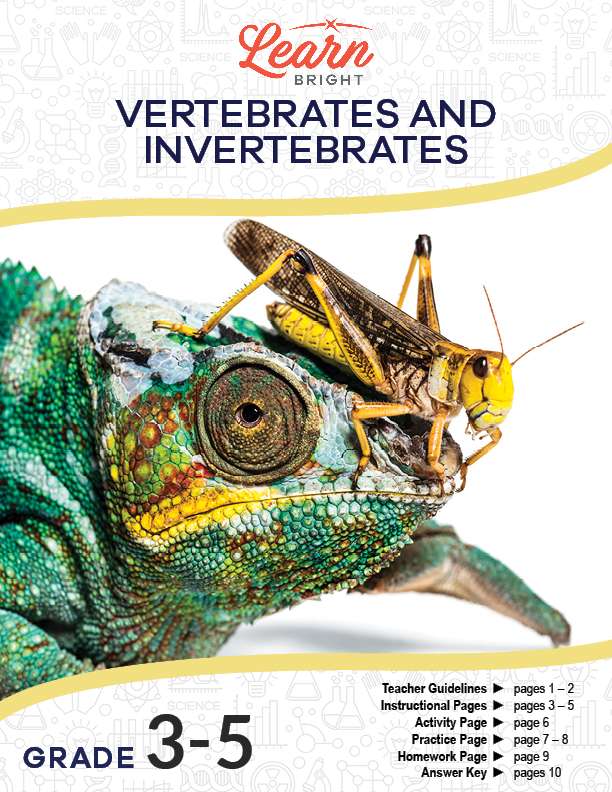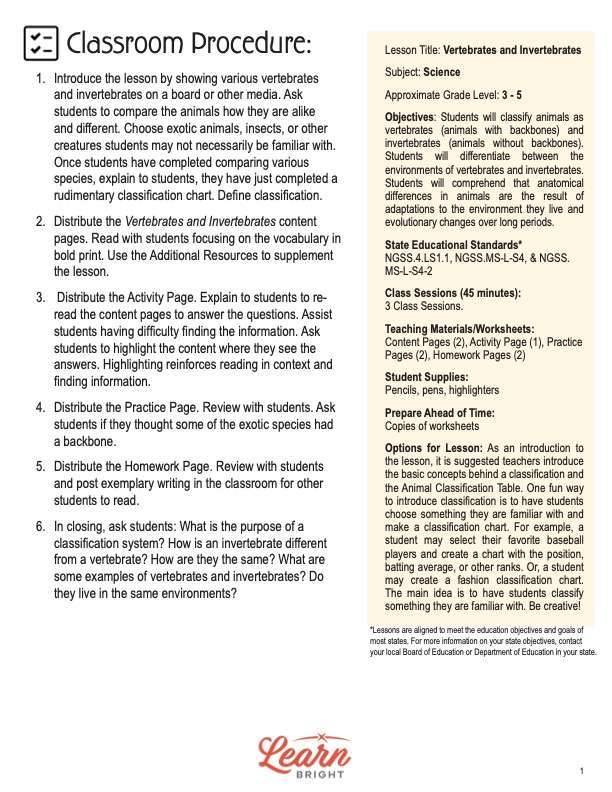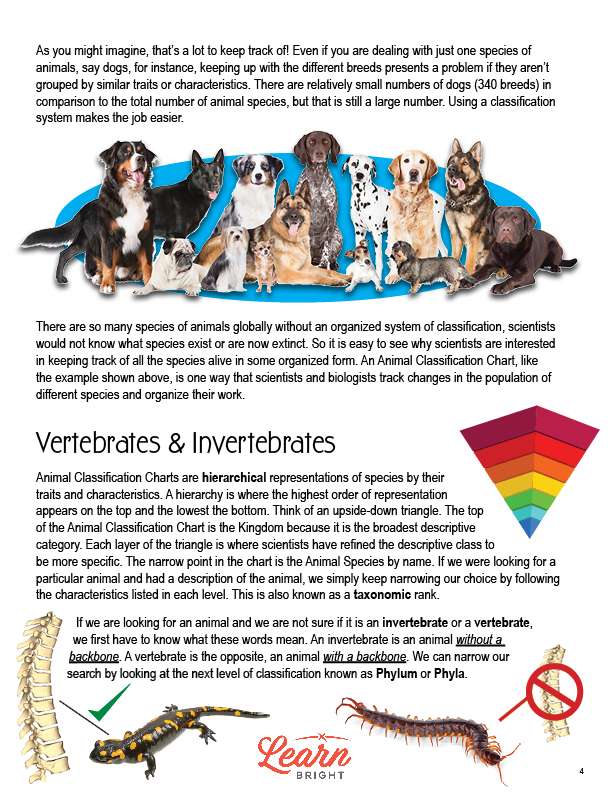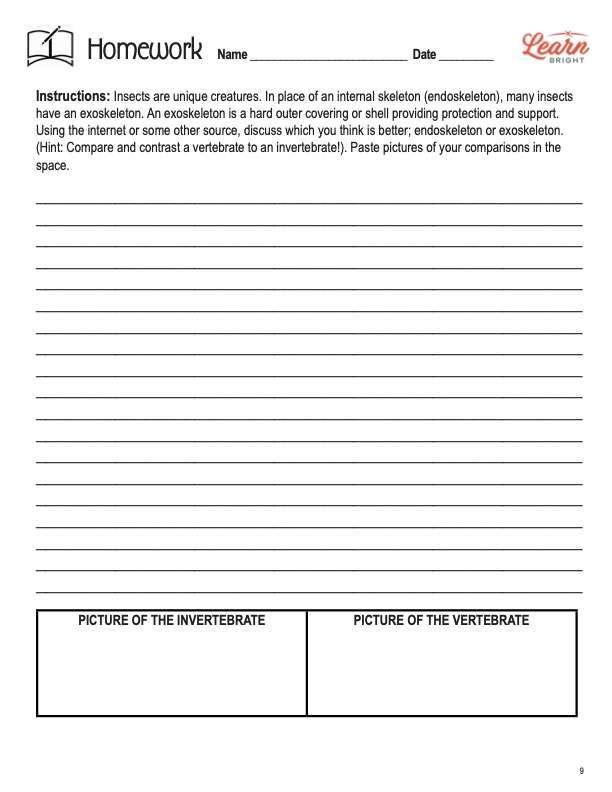Description
What our Vertebrates and Invertebrates lesson plan includes
Lesson Objectives and Overview: Vertebrates and Invertebrates is an excellent lesson for teaching students how to classify animals. Specifically, they will learn that vertebrates are animals with a backbone and that invertebrates are animals without a backbone. They will likewise differentiate between the environments of the two classes. Knowing the traits of these environments will help them discern if an animal has a backbone. This lesson is for students in 3rd grade, 4th grade, and 5th grade.
Classroom Procedure
Every lesson plan provides you with a classroom procedure page that outlines a step-by-step guide to follow. You do not have to follow the guide exactly. The guide helps you organize the lesson and details when to hand out worksheets. It also lists information in the yellow box that you might find useful. You will find the lesson objectives, state standards, and number of class sessions the lesson should take to complete in this area. In addition, it describes the supplies you will need as well as what and how you need to prepare beforehand. The items you will need to supply in addition to the worksheets are pictures of different vertebrate animals, pipe cleaners or toothpicks, and modeling clay or play dough. If you want, you can have students make their own clay for the activity. In this case, you will need salt, flour, and water.
Options for Lesson
The “Options for Lesson” section includes several ideas for things you can do as additional activities or alternatives for the lesson. One option is to use an animal classification table to introduce the lesson. You could also have students choose something they are familiar with and make a classification chart. For instance, if they love baseball, they can select their favorite players and create a chart with positions batting averages and other ranks. Or a student might create a fashion classification chart. This will allow students to learn how to classify things they are familiar with.
Teacher Notes
The paragraph on this page provides a little extra guidance for the lesson. It discusses what you should expect from the lesson. In addition, there are some blank lines you can use to write down any other ideas or thoughts you have about the lesson before you present it to your class.
VERTEBRATES AND INVERTEBRATES LESSON PLAN CONTENT PAGES
Introduction to Classification
The Vertebrates and Invertebrates lesson plan introduces the concept of how scientists organize things in different ways to keep track of them. There are three pages of content in the lesson. Students will first learn to define classification. This is the process by which scientists organize animals by their similar or shared traits.
The lesson lists how many species of animals and plants there are. There are 1.2 million animal species and 900,000 species of insects. There are also 391,000 plant species in the world. However, this list is incomplete. Students will learn that scientists have yet to discover every species of every living organism on the planet. In fact, they believe there may be as many as 9 million animal species, not just 1.2 million.
Vertebrates and Invertebrates
When it comes to animals, scientists use classification charts to help them organize all the different animals into groups. They start with the most general traits and then divide them into smaller and smaller groups. The lesson describes the concept of a hierarchical representation of species through and upside down triangle with different colors to represent smaller and smaller groups.
Students will learn that the phylum level is where they can discover whether an animal is a vertebrate or invertebrate. The differences between these two groups goes beyond the presence or lack of a backbone. The lesson describes how we can narrow things down further via the Chordata classification level. This level classifies animals by whether or not, at some stage of development, they had a flexible spinal column and nerve cord running along their back.
The lesson provides a list of traits that fit most invertebrates and most vertebrates. Invertebrates are generally cold-blooded. They breathe through the surface of the body, through gills, or through a tracheae. Their blood vascular system is open, closed, or absent entirely. They may also have the power to regenerate to a certain extent.
Vertebrates, on the other hand, may be either warm-blooded or cold-blooded. They breathe either through lungs or through gills. The blood vascular system in vertebrates is closed and much developed. Their power to regenerate is usually poor.
Key Terms
Here is a list of the vocabulary words students will learn in this lesson plan:
- Classification: the process scientists use to organize the things they are studying by their similar traits
- Hierarchy: a system of ordering in which the highest order of representation appears at the top and the lowest at the bottom
- Taxonomic rank: narrowing something down by certain characteristics in lower and lower levels
- Invertebrate: an animal without a backbone
- Vertebrate: an animal with a backbone
- Phylum (phyla): the level below kingdom and above class in the animal classification chart
- Chordata: a trait for animals that have a flexible spinal column and nerve cord running along the back, or had at some point during development
VERTEBRATES AND INVERTEBRATES LESSON PLAN
Included in the Vertebrates and Invertebrates lesson plan are three worksheets: an activity, a practice worksheet, and a homework assignment. Each worksheet will help students better grasp the concepts and material they learned throughout the lesson. The guide on the classroom procedure page outlines when to hand each one out to the class.
MAKE A MODEL ACTIVITY
For the activity, students will choose a specific vertebrate animal of which they will make a model. The worksheet lists the supplies they will need, including modeling clay or play dough, pipe cleaners or toothpicks, and a picture of their animal for reference. You can provide the pictures or have students find their own.
Students will paste the picture of the animal into the box in the top-right corner of the worksheet or draw it directly in the box. Then they will research how many vertebrae the animal has and make a model of the animal. The worksheet outlines the directions step by step. You may need to assist students at some point to ensure they understand how to make the model properly. The recipe to make modeling clay is at the bottom of the worksheet.
VERTEBRATES AND INVERTEBRATES PRACTICE WORKSHEET
For the practice worksheet, students will determine whether animals are vertebrates or invertebrates. The first part presents a list of 24 different species. They will mark either a “V” or an “I” next to the name. Next, there are three pictures of animals beneath the chart. Students will have to guess the right class based on the clues in the pictures.
Finally, students will read a short story in which someone finds the bones of an animal. Students will look at the picture of the bones. They will then explain how to use a classification chart to find out what animal it is.
ENDOSKELETON OR EXOSKELETON HOMEWORK ASSIGNMENT
The homework assignment focuses on insects and how they have exoskeletons versus endoskeletons. Students will research this topic and discuss which skeleton they think is better. They will have to compare vertebrates to invertebrates. They will also provide pictures of both classes in the space provided.
WORKSHEET ANSWER KEYS
There are answer keys at the end of the document for both the practice and homework worksheets. Students’ answers for the prompt about Allan will vary, but the answer key provides a sample response to which you can compare students’ responses. For the homework answer key, students will have varying answers. The paragraph in red describes what to look for when grading their responses. If you choose to administer the lesson pages to your students via PDF, you will need to save a new file that omits these pages. Otherwise, you can simply print out the applicable pages and keep these as reference for yourself when grading assignments.










